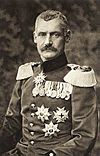Monarchy of Aretias: Difference between revisions
No edit summary |
No edit summary |
||
| Line 3: | Line 3: | ||
| border = | | border = | ||
| royal_title = Basileus | | royal_title = Basileus | ||
| realm = | | realm = the Mysians | ||
| native_name = | | native_name = | ||
| coatofarms = Coat of Arms of Aretias.png | | coatofarms = Coat of Arms of Aretias.png | ||
| Line 19: | Line 19: | ||
| website = | | website = | ||
}} | }} | ||
The '''Monarch of Aretias''' | The '''Monarch of Aretias''', officially the '''Basileus of the Mysians ''' ([[wikipedia:Pontic Greek|Mysian]]: Βασιλεὺς τῆς Ἀρητιάς; [[wikipedia:Armenian language|Vardanan]]: Բասիլեuսէ Արետիաս), is the [[wikipedia:head of state|head of state]] and [[wikipedia:head of government|head of government]] of the [[Aretias|Kingdom of Aretias and the Mysians]]. | ||
==History== | ==History== | ||
The Aretian monarchy traces its claim to the modern Kingdom of Mysia, which ruled over the modern [[Mysia|Commonwealth of Mysia]] in present day [[Vardana]], the islands of [[Aretias]], and parts of western [[Perateia]] from 1830 to 1901 and 1933 to present. The Kingdom of Mysia, and by extension Aretias, was first ruled by the [[House of Kamytzes]], descending from [[David Kamytzes|David Kamytzes, Despot of Mysia]]. Kamytzes's son, [[David I of Mysia|Constantine Kamytzes]], held the distinction as Despot of Mysia during the [[Vardana]]-[[Lihnidos]] union, and upon its dissolution proclaimed himself [[Monarchy of Vardana|Basileus of Vardana]], Basileus of Mysia, and [[Monarchy of Lihnidos|Emperor of Lihnidos]], based on rule in Mysia and descent from [[Manuel II of Vardana and Lihinidos|Basileus Manuel II]]. The rule of the House of Kamytzes ended in 1901 during the reign of [[George | The Aretian monarchy traces its claim to the modern Kingdom of Mysia, which ruled over the modern [[Mysia|Commonwealth of Mysia]] in present day [[Vardana]], the islands of [[Aretias]], and parts of western [[Perateia]] from 1830 to 1901 and 1933 to present. The Kingdom of Mysia, and by extension Aretias, was first ruled by the [[House of Kamytzes]], descending from [[David Kamytzes|David Kamytzes, Despot of Mysia]]. Kamytzes's son, [[David I of Mysia|Constantine Kamytzes]], held the distinction as Despot of Mysia during the [[Vardana]]-[[Lihnidos]] union, and upon its dissolution proclaimed himself [[Monarchy of Vardana|Basileus of Vardana]], Basileus of Mysia, and [[Monarchy of Lihnidos|Emperor of Lihnidos]], based on rule in Mysia and descent from [[Manuel II of Vardana and Lihinidos|Basileus Manuel II]]. The rule of the House of Kamytzes ended in 1901 during the reign of [[George II of Mysia|Basileus George II]], when the kingdom was absorbed into the [[House of Hazarasp|Hazaraspid]] [[Vardana|Kingdom of Vardana]]. | ||
Mysia again asserted its independence in 1924, during the [[Vardanan revolution]] when [[George II of Mysia|Basileus George II]] was proclaimed Basileus of Mysia. George II was briefly restored to the Mysian throne, though by 1930 the kingdom had lost its mainland territory and retreated to the island of [[Aretias]], previously under the control of the Princely House of Bznuni. At George II's death, he was succeeded by his daughter, [[Irene I of Aretias|Irene]], and entered a [[wikipedia:Personal union|personal union]] with the [[Garima|Gariman state]] of [[Nyrundy]]. Aretias was ruled by the House of Nyrundy from 1967 to 2014 – though Irene's husband [[John VII, Elector of Nyrundy]] was Basileus of | Mysia again asserted its independence in 1924, during the [[Vardanan revolution]] when [[George II of Mysia|Basileus George II]] was proclaimed Basileus of Mysia. George II was briefly restored to the Mysian throne, though by 1930 the kingdom had lost its mainland territory and retreated to the island of [[Aretias]], previously under the control of the Princely House of Bznuni. At George II's death, he was succeeded by his daughter, [[Irene I of Aretias|Irene]], and entered a [[wikipedia:Personal union|personal union]] with the [[Garima|Gariman state]] of [[Nyrundy]]. Aretias was ruled by the House of Nyrundy from 1967 to 2014 – though Irene's husband [[John VII, Elector of Nyrundy]] was Basileus of of the Mysians by right of his wife from 1933 until his death in 1960. From 1924 until 1934, the second Mysian Kingdom controlled much of what is now the Vardanan province of [[Mysia]], including [[Aretias]]. | ||
Since 2014, the [[House of Bznuni]] has ruled [[Aretias]] while still claiming Mysian, Vardanan, and Lihnidosi royal and imperial titles. | Since 2014, the [[House of Bznuni]] has ruled [[Aretias]] while still claiming Mysian, Vardanan, and Lihnidosi royal and imperial titles. | ||
| Line 29: | Line 29: | ||
The monarch is the absolute monarch of Aretias. As head of state, the monarch is the chief executive and chief representative of Aretias internationally. In addition, the monarch wields tremendous legislative and judicial authority. While some legislative functions are carried out by the [[Royal Council (Aretias)|Royal Council]], the monarch has the sole power to appoint or remove councillors, of which the monarch presies over. This system results in royal decrees forming the basis of the country's legislation – this is often done in concert and through the Royal Council. In practice, major policy decisions are often derived from the Royal Council. From 1945 to 2010, the Royal Council weilded tremendous authority due to the monarch's primary residence in [[Nyrundy]] during this period. Since 2010, the power of the Royal Council has waned. | The monarch is the absolute monarch of Aretias. As head of state, the monarch is the chief executive and chief representative of Aretias internationally. In addition, the monarch wields tremendous legislative and judicial authority. While some legislative functions are carried out by the [[Royal Council (Aretias)|Royal Council]], the monarch has the sole power to appoint or remove councillors, of which the monarch presies over. This system results in royal decrees forming the basis of the country's legislation – this is often done in concert and through the Royal Council. In practice, major policy decisions are often derived from the Royal Council. From 1945 to 2010, the Royal Council weilded tremendous authority due to the monarch's primary residence in [[Nyrundy]] during this period. Since 2010, the power of the Royal Council has waned. | ||
While the monarch is the primary judicial authority in Aretias, judicial reforms in the mid-20th century were established to provide Aretias a limited judiciary in the Belisarian model. However, this judiciary lacks any meaningful | While the monarch is the primary judicial authority in Aretias, judicial reforms in the mid-20th century were established to provide Aretias a limited judiciary in the Belisarian model. However, this judiciary lacks any meaningful independence and the monarch heavily influences judicial decisions through intervention in cases or, more often, issuing a verdict on appeal. | ||
In addition, the monarch is the commander-in-chief of the [[Aretian Defense Force]], as well as the Royal Guard and Civil Guard. | In addition, the monarch is the commander-in-chief of the [[Aretian Defense Force]], as well as the Royal Guard and Civil Guard. | ||
==Titles, styles and honors== | ==Titles, styles and honors== | ||
Aretian royal titles and styles are primarily derived from the former Mysian kingdom and the Kingdom of Greater Vardana. The primary style utilzed by the monarch is ''Royal and Apostolic Majesty'' ("''HRAM''"), which was previously utilzed by Vardanan monarchs and later Mysian monarchs. Since the kingdom's inception, the monarch of Aretias has claimed the titles of Mysia and the Vardanan-Lihnidosi personal union, as such many titles utilzed by the monarch are simply held in pretense, and are contested by at least one other claimant or party. The royal title saw the addition Aretias in 1930. From 1933 to 2010, the Baselius of Aretias was concurrently the Elector of Nyrundy and Archduke of Nyrundy. Even though Lihnidosi titles such as Emperor of Lihnidos and King of Thasos fell out of active use during the Nyrundy personal union, there has been no | Aretian royal titles and styles are primarily derived from the former Mysian kingdom and the Kingdom of Greater Vardana. The primary style utilzed by the monarch is ''Royal and Apostolic Majesty'' ("''HRAM''"), which was previously utilzed by Vardanan monarchs and later Mysian monarchs. Since the kingdom's inception, the monarch of Aretias has claimed the titles of Mysia and the Vardanan-Lihnidosi personal union, as such many titles utilzed by the monarch are simply held in pretense, and are contested by at least one other claimant or party. The royal title saw the addition Aretias in 1930. From 1933 to 2010, the Baselius of Aretias was concurrently the Elector of Nyrundy and Archduke of Nyrundy. Even though Lihnidosi titles such as Emperor of Lihnidos and King of Thasos fell out of active use during the Nyrundy personal union, there has been no explicit renunciation of these claims. | ||
The monarch's current title and style is: | The monarch's current title and style is: | ||
:Basileus of | :Basileus of the Mysians, King of Greater Vardana, Grand Prince of the East, First Venerable One, Bridger of Seas, Master of the Periclean and the Ozeros, Sovereign Ruler and Lord of the Scipian Provinces and the lands in between, Protector and Defender of the Apostolic Faith. | ||
===Title of the heir apparent=== | ===Title of the heir apparent=== | ||
From 1736 to 1830, the House of Kamytzes held the distinction of Despot of Mysia. Since 1830, this previously non-hereditary administrative title has been granted to the heir apparent or chosen heir of Mysia and later Aretias. The heir is afforded the style of ''Royal and Apostolic Highness'' ("''HRAH''"). The feminine title is Despoina, which differs from that of Despotissa for the wife of the Despot. The title has been granted to female | From 1736 to 1830, the House of Kamytzes held the distinction of Despot of Mysia. Since 1830, this previously non-hereditary administrative title has been granted to the heir apparent or chosen heir of Mysia and later Aretias. The heir is afforded the style of ''Royal and Apostolic Highness'' ("''HRAH''"). The feminine title is Despoina, which differs from that of Despotissa for the wife of the Despot. The title has been granted to female heirs presumptive on two occasions: in 2007 to [[Irene II of Aretias|Irene, Despoina of Mysia]] and in 2016 to [[Zenobia, Despoina of Mysia]]. The current heir presumptive is [[Zenobia, Despoina of Mysia]], who may be displaced by the birth of a younger, legitimate brother. | ||
==Succession== | ==Succession== | ||
{{main|Succession to the Aretian throne}} | {{main|Succession to the Aretian throne}} | ||
Revision as of 19:16, 11 August 2020
| Basileus of the Mysians | |
|---|---|
 | |
| Incumbent | |
 | |
| Basil I since 20 September 2014 | |
| Details | |
| Style | His Royal and Apostolic Majesty |
| Heir presumptive | Zenobia, Despoina of Mysia |
| First monarch | David I |
| Formation | 2 September 1830 |
| Residence | Phaistros(historical) Palataki (modern) |
The Monarch of Aretias, officially the Basileus of the Mysians (Mysian: Βασιλεὺς τῆς Ἀρητιάς; Vardanan: Բասիլեuսէ Արետիաս), is the head of state and head of government of the Kingdom of Aretias and the Mysians.
History
The Aretian monarchy traces its claim to the modern Kingdom of Mysia, which ruled over the modern Commonwealth of Mysia in present day Vardana, the islands of Aretias, and parts of western Perateia from 1830 to 1901 and 1933 to present. The Kingdom of Mysia, and by extension Aretias, was first ruled by the House of Kamytzes, descending from David Kamytzes, Despot of Mysia. Kamytzes's son, Constantine Kamytzes, held the distinction as Despot of Mysia during the Vardana-Lihnidos union, and upon its dissolution proclaimed himself Basileus of Vardana, Basileus of Mysia, and Emperor of Lihnidos, based on rule in Mysia and descent from Basileus Manuel II. The rule of the House of Kamytzes ended in 1901 during the reign of Basileus George II, when the kingdom was absorbed into the Hazaraspid Kingdom of Vardana.
Mysia again asserted its independence in 1924, during the Vardanan revolution when Basileus George II was proclaimed Basileus of Mysia. George II was briefly restored to the Mysian throne, though by 1930 the kingdom had lost its mainland territory and retreated to the island of Aretias, previously under the control of the Princely House of Bznuni. At George II's death, he was succeeded by his daughter, Irene, and entered a personal union with the Gariman state of Nyrundy. Aretias was ruled by the House of Nyrundy from 1967 to 2014 – though Irene's husband John VII, Elector of Nyrundy was Basileus of of the Mysians by right of his wife from 1933 until his death in 1960. From 1924 until 1934, the second Mysian Kingdom controlled much of what is now the Vardanan province of Mysia, including Aretias.
Since 2014, the House of Bznuni has ruled Aretias while still claiming Mysian, Vardanan, and Lihnidosi royal and imperial titles.
Role
The monarch is the absolute monarch of Aretias. As head of state, the monarch is the chief executive and chief representative of Aretias internationally. In addition, the monarch wields tremendous legislative and judicial authority. While some legislative functions are carried out by the Royal Council, the monarch has the sole power to appoint or remove councillors, of which the monarch presies over. This system results in royal decrees forming the basis of the country's legislation – this is often done in concert and through the Royal Council. In practice, major policy decisions are often derived from the Royal Council. From 1945 to 2010, the Royal Council weilded tremendous authority due to the monarch's primary residence in Nyrundy during this period. Since 2010, the power of the Royal Council has waned.
While the monarch is the primary judicial authority in Aretias, judicial reforms in the mid-20th century were established to provide Aretias a limited judiciary in the Belisarian model. However, this judiciary lacks any meaningful independence and the monarch heavily influences judicial decisions through intervention in cases or, more often, issuing a verdict on appeal.
In addition, the monarch is the commander-in-chief of the Aretian Defense Force, as well as the Royal Guard and Civil Guard.
Titles, styles and honors
Aretian royal titles and styles are primarily derived from the former Mysian kingdom and the Kingdom of Greater Vardana. The primary style utilzed by the monarch is Royal and Apostolic Majesty ("HRAM"), which was previously utilzed by Vardanan monarchs and later Mysian monarchs. Since the kingdom's inception, the monarch of Aretias has claimed the titles of Mysia and the Vardanan-Lihnidosi personal union, as such many titles utilzed by the monarch are simply held in pretense, and are contested by at least one other claimant or party. The royal title saw the addition Aretias in 1930. From 1933 to 2010, the Baselius of Aretias was concurrently the Elector of Nyrundy and Archduke of Nyrundy. Even though Lihnidosi titles such as Emperor of Lihnidos and King of Thasos fell out of active use during the Nyrundy personal union, there has been no explicit renunciation of these claims.
The monarch's current title and style is:
- Basileus of the Mysians, King of Greater Vardana, Grand Prince of the East, First Venerable One, Bridger of Seas, Master of the Periclean and the Ozeros, Sovereign Ruler and Lord of the Scipian Provinces and the lands in between, Protector and Defender of the Apostolic Faith.
Title of the heir apparent
From 1736 to 1830, the House of Kamytzes held the distinction of Despot of Mysia. Since 1830, this previously non-hereditary administrative title has been granted to the heir apparent or chosen heir of Mysia and later Aretias. The heir is afforded the style of Royal and Apostolic Highness ("HRAH"). The feminine title is Despoina, which differs from that of Despotissa for the wife of the Despot. The title has been granted to female heirs presumptive on two occasions: in 2007 to Irene, Despoina of Mysia and in 2016 to Zenobia, Despoina of Mysia. The current heir presumptive is Zenobia, Despoina of Mysia, who may be displaced by the birth of a younger, legitimate brother.
Succession
List
As Monarchs of Mysia
| Name | Portrait | Arms | Birth | Marriages | Death | House |
|---|---|---|---|---|---|---|
| David I 2 September 1830 – 1 June 1861 |

|

|
1 January 1799 Leonopolis Son of David, Despot of Mysia and Anna Levidis |
Maria of Ravenna Hagia Anthemia 9 June 1829 5 children |
1 June 1861 Norashen aged 62 |
Kamytzes |
| David II 1 June 1861 – 8 March 1864 |

|

|
16 July 1831 Phaistros Son of David I and Maria of Ravenna |
PLACEHOLDER Hagia Anna DATE 2 children |
30 May 1869 Kepetta aged 37 | |
| Andreas I 8 March 1864 – 4 June 1881 |

|

|
22 April 1804 Phaistros Son of David, Despot of Mysia and Anna Levidis |
PLACEHOLDER Hagia Anna DATE 8 children |
4 June 1881 Kepetta aged 77 | |
| George I 4 June 1881 – 28 November 1890 |

|

|
9 September 1828 Phaistros Son of Andreas I and PLACEHOLDER |
PLACEHOLDER Hagia Anna DATE 1 child |
28 November 1890 Palatium Blachernae aged 62 | |
| (1st reign) George II 28 November 1890 – 6 September 1901 (Deposed) |

|

|
26 February 1852 Phaistros Son of George I and PLACEHOLDER |
(1) PLACEHOLDER Hagia Anna DATE 2 children (2) Anna of Latium Hagia Anthemia 18 May 1896 4 children |
3 May 1933 Phaistros aged 81 |
As Monarchs of Aretias and the Mysians
| Name | Portrait | Arms | Birth | Marriages | Death | House |
|---|---|---|---|---|---|---|
| (2nd reign) George II 19 July 1924 – 3 May 1933 |

|

|
26 February 1852 Phaistros Son of George I and PLACEHOLDER |
(1) PLACEHOLDER Hagia Anna DATE 2 children (2) Anna of Latium Hagia Anthemia 18 May 1896 4 children |
3 May 1933 Phaistros aged 81 |
Kamytzes |
| Irene I 3 May 1933 – 4 May 1967 |

|

|
1 July 1895 Phaistros Daughter of George I and Anna of Latium |
John VII, Elector of Nyrundy Rovan 1914 # children |
4 May 1967 Rovan aged 70 | |
| (Jure uxoris) John I 3 May 1933 – 8 December 1960 |

|

|
11 January 1890 Rovan Son of Otto X, Elector of Nyrundy and Enora Rouanti |
Irene I of Mysia Rovan 1914 # children |
8 December 1960 Rovan aged 70 |
Nyrundy |
| Stephen I 4 May 1967 – 17 June 1984 |

|
17 May 1915 Rovan Son of Irene I and John VII, Elector of Nyrundy |
Silvia of Ravenna Rovan 4 February 1936 # children |
17 June 1984 Rovan aged 69 | ||
| George III 17 June 1984 – 17 July 2010 |

|
30 May 1937 Palataki Son of Stephen I and Silvia of Ravenna |
Anna of Ghant Rovan 17 January 1961 5 children |
17 July 2010 Rovan aged 70 | ||
| Irene II 17 July 2010 – 20 September 2014 (Abdicated) |

|

|
9 September 1964 Rovan Daughter of George III and Anna of Ghant |
Prince Cyril Bznuni Sacred Heart Basilica 8 January 1986 5 children |
Living age 60 | |
| (Jure uxoris) Cyril I 17 July 2010 – 10 September 2014 |

|

|
8 March 1959 Palataki Son of Prince Tigran Bznuni and PLACEHOLDER |
Irene II of Aretias Sacred Heart Basilica 8 January 1986 5 children |
8 September 2014 Teos aged 55 |
Bznuni |
| Basil I 20 September 2014 – present |

|

|
16 July 1987 Palataki Son of Irene II and Prince Cyril Bznuni |
(1) Maria Verrucosa Hagia Anthemia 9 July 2013 1 child (2) Cassandra of Ghant Sacred Heart Basilica 2 February 2020 no children 2 illegitimate children |
Living age 36 |